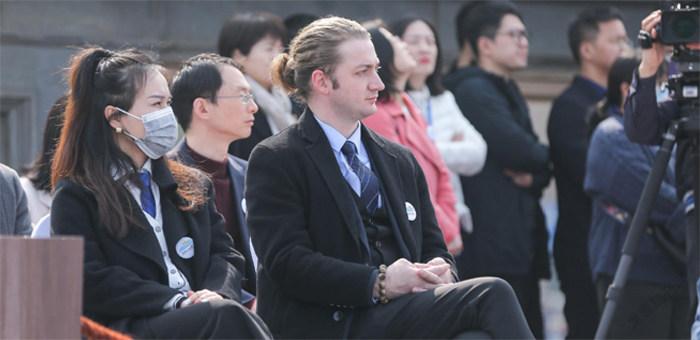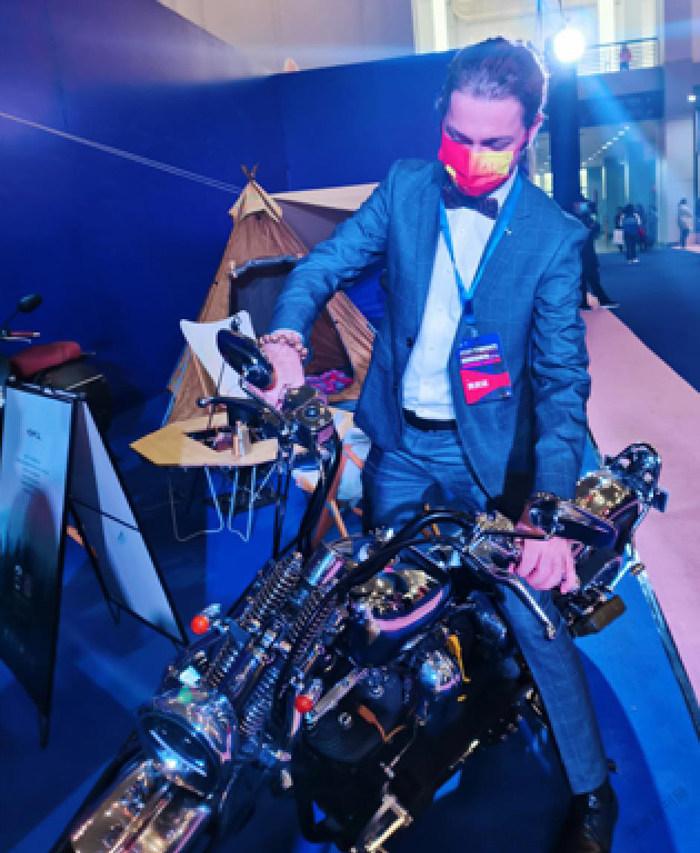我看葛家村变迁
2022-04-27智其
智其



共同富裕的另一面是贫富两极分化,而今贫富之间不断拉大的差距已成为一个全球性问题。近几年来,中国的中长期发展理念发生了五次转变。其中包括:从追求增长率到更强调社会保障,从追求高效率到更强调公平,从倡导部分先富到强调共同富裕,从注重资本到更注重劳动力,从偏重房地产和金融业到更强调科学技术和制造业。这些调整为实现共同富裕奠定了坚实基础。我来自土耳其的一线城市布尔萨市,在宁波生活了近十年。只是用我的双眼,我就可以清楚地看到中国发生的巨大变化。新的建筑、新的道路和高速公路、新的地铁线、更干净的环境……这些都是非常直观的体现。浙江开启高质量发展建设共同示范区后,我能感觉到人们的精神也在富裕起来。
大学毕业后,我开始为一家在福布斯500强中排名第20位的公司工作,在阿曼担任项目主管,并领导一个跨国小队。后来,我收到了宁波一家外企的工作邀约,我没有丝毫犹豫,欣然接受了这份新工作。我认为这将是一个让我更深入了解中国文化和尝试新事物的好机会。2013年2月,我的中国之旅就这样开始了。
多年来在这家公司供应链的不同岗位上工作,让我积累了与世界上最大的能源、石油和天然气公司合作的经验。在“一带一路”倡议框架下,宁波与中东欧国家已成为重要合作伙伴。看到这个机会,我决定参与双边贸易,并利用我的农业专业,通过我的家族与匈牙利、捷克共和国和保加利亚的政府之间的密切关系,将农产品进口到宁波,利用我在中国的采购经验,向这些国家推广更高档次、更高标准的宁波产品。来到中国八年后,我于2021年在宁波创办了自己的公司。
在业余时间,我经常在浙江的农村地区进行短途旅行,看看美丽的风景,并试图了解更多的当地文化,宁海葛家村就是其中之一。几年前,我曾经游览过这个村庄,那时候的印象是居民大多是老年人。去年我又去了葛家村,那里已经发生了令人印象深刻的变化。
很难想象中国农村的日常生活被创意艺术画廊、用贝壳装饰的手工盆景和各种木制手工艺品所包围。当被问及你眼中的艺术是什么时,“谁一开始就知道艺术是什么呢?”葛家村的几位居民笑着说。这个村庄的历史可以追溯到1000多年前,现在居住着1600名村民,距离最近的城市中心约26公里。
这里缺乏有特色的农产品或企业来支撑当地经济。大多数年轻人离开村庄去寻找工作,留下不少老年人。村民们告诉我,2019年4月,当中国人民大学艺术学院副教授丛志强第一次来到这个隐藏在山谷中不起眼的村庄时,没有人相信他能通过“艺术”致富,有些人甚至说他是骗子。丛教授第一天上课的时候,只有20多个村民来听课,下课时只剩下6个人。
后来,为了吸引更多的村庄参与改造,他的团队和一些村民用竹子和石头等廉价材料做了一把椅子,并把它装饰得五颜六色,还建了一个供孩子们娱乐的公共空间。很多村民很快意识到这一变化将要改善他们的生活,而一系列艺术装置也改变了他们的想法。“这是艺术?这么容易吗?我也能做到。”一个接一个,不少居民都开始尝试。
变化确实很快就来了。在第一轮改造中,全村花费5万多元用于购买材料和雇佣劳动力。为了降低成本,一个普通的水箱被一分为二,形成了装置的基础,一块废弃的门板被重新喷漆并附在设计上,一张独特的桌子就这样做成了。第一件作品引发了对更多物品的创作,大多数装饰品都是由废弃材料制成的。当然,最让村民们惊讶的是,通过清理村庄,通过创造有趣的艺术作品,他们获得了更高的收入。
55岁的村民袁小仙(音译)发现自己很有色彩天赋。在丛教授的鼓励下,经过大约一周的学习,袁小仙就能够制作一些布料玩具,比如十二生肖动物,现在网上售价从30元到200多元不等。她的手工艺品也在县里的快递站出售,那里经常接待经过该地区的游客。
投入了相应的时间和精力,袁小仙2020年的收入达到了15万元,相比2018年4万元的年收入差不多翻了4倍。在更高收入的激励下,更多的村民加入到“通过艺术共同富裕”的努力中来,有些年轻人甚至开始回村创业。“80后”葛品高(音译)就是其中之一。他于2019年8月通过装修奶奶的老房子,把它改造成一个真正的酒吧,吸引游客来喝点小酒、吃点烧烤、聊点小天。2020年,酒吧营收达到15万元,预计今年将达到20万元。
29岁的张有利(音译)是今年刚从城里返回村里的。“村里的变化给我留下了深刻的印象,我希望能有更多的时间和家人在一起。”她说道。她曾在一家美容院工作,现在她可以自主地出售自己的木制手工艺品。
在中国的其他一些村庄,当地政府聘请的艺术家和规划师向村民介绍艺术项目,但当地居民往往不能认同艺术的价值。与此不同的是,葛家村很好地解決了这个问题。在认识了什么是艺术后,葛家村村民自己设计、自己制作艺术类产品,我认为这是成功背后最重要的因素。
浙江正以高质量发展为重点,谋划到2025年推动示范区建设取得明显的实质性进展。在村民眼中,共同富裕不仅意味着物质上的富足,更意味着精神上的富有。“头脑富有,口袋富足”,葛家村许多村民从艺术中寻求快乐——大多数村民已经过了退休年龄,有时也会感到孤独。全村目前有138名艺术家,他们从2019年开始就参与到用艺术改造葛家村社区的工作中。
重要的是,要让村民们看到艺术如何能够帮助他们赚钱,以此激励他们。精神上的充实也会给他们带来信心。一个更干净、更美观的村庄,加上专业旅游公司的运作,将带来更多的游客,增加村民的收入。2021年,浙江省农村居民人均可支配收入35247元,连续37年居全国首位。根据当地统计局的数据,宁海县农村居民人均可支配收入在2020年达到36166元,过去五年的平均增长率为8.3%。
葛家村村民还向贵州省一些发展较为落后的村庄分享了他们的经验。不到半天,当地村民就卖出了价值5万元左右的手工艺品。“我们富了,还要帮助别人一起富。”葛家村的村民说道。对我来说,这就是共同富裕。
在我看来,这些小步骤已经为一个雄心勃勃的长期愿景奠定了坚实基础。随着葛家村的成功,说服周围的其他村庄就容易多了。然而,应该避免同质化,毕竟你不能总是复制一件艺术作品。每个村庄都应该根据自己的特点进行改造。附近的涨坑村旨在将自己改造成一个功夫主题村,游客可以在这里体验功夫艺术和文化,而附近的毛洋村则旨在变成一个爱情主题艺术村,以吸引更多游客。
The opposite side of common prosperity is the polarization between the rich and the poor, which has become a global problem. In recent years, five shifts have taken place in China’s mid-and long-term development philosophy. These include the shift from growth rate to social security, from efficiency to fairness, from early prosperity for some to common prosperity, from capital to labor, and from real estate and finance to science, technology and manufacturing.
These changes have laid a solid foundation for moving to the next target — realizing common prosperity.
Coming from Bursa, Turkey, I lhave lived in Ningbo for almost a decade now. With my eyes, I can see the massive physical development crystal clear. New buildings, new roads, highways, metro lines, cleaner environment and so on. After Zhejiang was announced as the pilot zone for common prosperity, I can feel people’s minds are getting rich as well; it is obvious that people already spiritually engaged.
After graduation from university, I started working for a company ranked 20th on Forbes 500. In Oman, I served as a project supervisor and supervised a multinational team. Afterwards I received an offer from a foreign enterprise in Ningbo. I didn’t hesitate even a minute. I was thinking this would be a nice opportunity to know Chinese culture and try new things. That’s how my China journey started in February 2013.
Years working in different roles within the supply chain of the company gave me the experience working with the world largest companies within energy and oil & gas sectors.
Under the framework of the Belt and Road Initiative, Ningbo and the CEEC have become important partners. Seeing the opportunity, I had decided to get involved in promoting high-grade, high-standard agricultural products from Ningbo to Hungary, Czech Republic and Bulgaria and importing products from these countries to Ningbo, using my academic knowledge in agriculture, along with the strong relationships with authorities in these countries through my family connections in the region and my procurement experience in China. Eight years after arriving in China, I started my own company in Ningbo in 2021.
In my free time I often take short trips in Zhejiang’s rural areas to see nice sceneries and try to know more of local culture. Gejia village in Ninghai is one of them.
Several years ago, I visited the village, where the residents are mostly elder people. There is no any business opportunity for them. Last year I took another trip to Gejia village and I was greeted with an impressive change.
It's hard to imagine rural Chinese villages’ daily lives surrounded by creative art galleries, hand-made miniascape decorated with seashells, and various handcrafts made of wood.
When asked what is art in your eyes, “who knows what art was at the beginning?” giggled several residents of Gejia village in Ninghai county, Ningbo city. The village, with a history stretching back over 1,000 years and now home to 1,600 villagers, is about 26 kilometers away from the nearest urban center.
It was suffering from a lack of distinctive agricultural products or businesses to support the local economy. Most young people left the village in search of employment, leaving elderly residents behind to run things.
They told me that in April 2019, when Cong Zhiqiang, associate professor at the School of Art from Renmin University of China first came to this unremarkable village hidden in a mountain valley, nobody trusted him and even called him a “liar”. Only just over 20 villagers came to listen to Cong’s class on the first day, and only six remained when the class ended.
Later on, in order to attract more villagers to participate in the transformation, his team, together with some villagers, built a chair using bamboo and stones — all cheap materials, and decorated it colorfully/ They also opened up a public space for children to engage in recreational activities.
They quickly realized the change would improve our lives. A series of artistic installations changed their mindset. “This is art? Is it so easy? I can do it too,” and one by one they started to give it a try.
Changes quickly began. In the first round of transformation, the whole village spent over 50,000 yuan ($7,858) to buy materials and hire labor. In order to reduce costs, a common water tank was split in two to form the base of the installation, an abandoned door panel was repainted and attached to the design, and a unique table was thus made. The first piece sparked the creation of several more items, and most of the decorations were made from discardable materials.
What surprised the villagers the most was that cleaning up the village and creating interesting pieces of art brought them a higher income.
Yuan Xiaoxian, a 55-year-old villager, discovered that she had a talent for color. Encouraged by professor Cong, Yuan was able to make cloth toys, such as 12 Chinese zodiac animals, which are now sold online priced from 30 yuan to over 200 yuan, after learning for about one week. Her products are also sold in the county courier station, which often hosts tourists passing through the region.
With time and effort, Yuan’s income in 2020 reached 150,000 yuan, almost quadrupling her annual income was in 2018, which is only 40,000 yuan.
Incentivized by a higher income, more villagers joined in. Even some young people began to return to start their own businesses.
Ge Pin’gao, a man born after 1980, is one example. He opened a small bar in August 2019 by decorating and transforming his grandma’s old house, attracting visitors to enjoy drinks, barbeque and some chatting. In 2020, the bar’s revenue reached 150,000 yuan, and it is expected to reach 200,000 yuan this year.
Zhang Youli, a 29-year-old local villager, came back from the city this year. “The transformation in the village impressed me and I hope to spend more time with my family,” said Zhang. She used to work in a beauty salon, but now she is selling her own handcraft products made of wood at her own pace.
Unlike a number of other villages in China, where artists and planners hired by local governments introduced art projects to villagers but local residents failed to embrace the value of art, Gejia village could work it out. After being educated on what art is, Gejia villagers have designed and produced art products by themselves, and that, in my opinion, is the most important factor behind the success.
Zhejiang is building itself into a pilot zone for common prosperity by 2025 with a focus on high-quality development. In the villagers’ eyes, common prosperity means not only material wealth, but also spiritual engagement.
“Mind rich, pocket rich.” Many villagers are seeking happiness from embracing art as most of them have retired and sometimes feel lonely. The whole village currently has 138 artists who have participated in the transformation of the community using art since 2019.
It’s important to give villagers a vision of how art can help them make money as a way to motivate them. Spiritual enrichment will also bring them confidence. A cleaner and more aesthetic village, along with help from professional tourism firms, will bring more tourists and boost villagers’ income.
Zhejiang’s rural residents’ average disposable income was 35,247 yuan in 2021, the highest among China’s provinces for the 37th year in a row. For Ninghai county alone, its rural residents' average disposable income reached 36,166 yuan in 2020, with the average growth rate at 8.3 percent in past five years, according to the local statistics bureau.
Gejia village residents have shared their experiences with underdeveloped village in Southwest China’s Guizhou province. The local villagers have sold their hand-made crafts worth around 50,000 yuan in less than half-a-day. “If we become rich, we will help others to become rich together,” one villager said. To me, that’s common prosperity.
In my eyes, these small steps have set a ball in motion for an ambitious long-term vision. Following Gejia’s success, it’s much easier to convince other villages around. However, homogenization should be avoided. After all, you can’t always copy an art work. Each village should be transformed based on their own characteristic.
Zhangkeng village, which is nearby, is aimed at establishing itself as a Kungfu-themed village, where visitors can experience the Kungfu culture, while another village Maoyang aims to become a wedding-themed village to attract more visitors.
